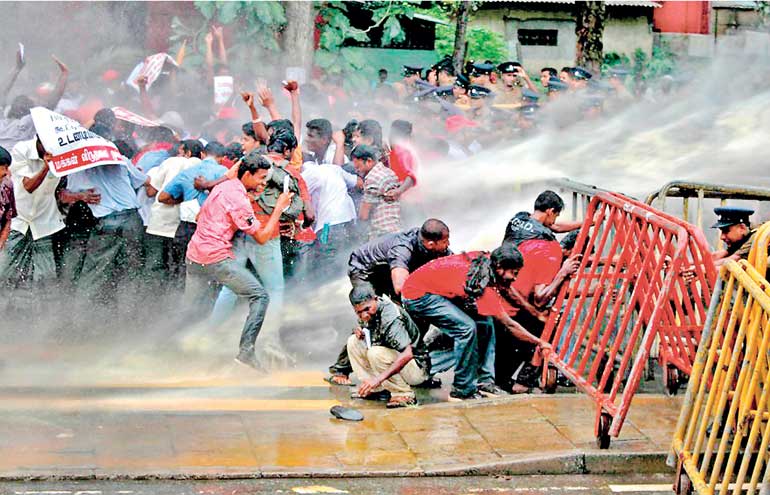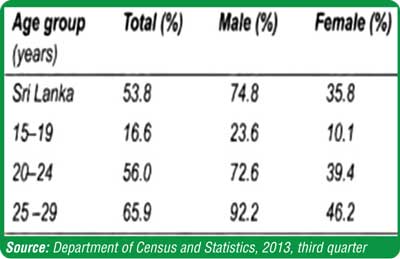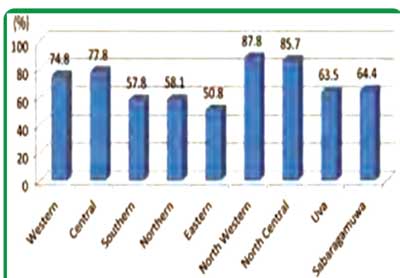Sunday Mar 16, 2025
Sunday Mar 16, 2025
Thursday, 4 February 2016 16:05 - - {{hitsCtrl.values.hits}}

Youth unemployment is creating a significant development gap in the country with almost 20% of the population, both willing and able to work, not having jobs
 By Aisha Wahab
By Aisha Wahab
The theory behind who you identify yourself as and how it affects your place in society and outcomes of your decisions is known as identity economics. This article will explore the youth unemployment crisis in Sri Lanka through the eyes of this theory, which is threefold: gender, region and caste.
Youth unemployment is creating a significant development gap in the country with almost 20% of the population, both willing and able to work, not having jobs. The national youth policy of Sri Lanka defines youth as between 15-29 years of age. The rate of unemployment of youth between these said ages are greater than those aged 30-40+, as reported by the National Human Development Report (NHDR) 2014.
What is truly shocking is the statistics within the statistics. It reports that of this spectrum of the unemployed, 60% of the youth were women who had no jobs, despite women having a higher level of qualification in comparison to their male colleagues at the workplace. Some of us are already facing this problem while the rest of us are not too far behind.
Solving the basics in the issue of unemployment will help Sri Lanka bring back the big numbers of students going abroad to study, eventually find a job and settle down there. If these students had the assurance that they would get a respectable job back at home, the mind-set would be different and we will have a more efficient workforce, while saving some foreign currency.
Now how does who you are determine how high you will fly? The issue of identity can be broken down into predominantly three aspects, namely, gender, region and caste.
Gender

Occupational segregation is one of the most stubborn features of the labour market here in Sri Lanka. The youth unemployment challenge is fuelled by gender asymmetry where female youth unemployment is almost double that of male youth unemployment.
Sri Lanka is also a state with a large gender gap in employment (20th-ILO). From the early 2000s, the gender gap has been persistent throughout. The main reason for this occupational segregation is ‘Job Tags’. In society, there are, what is colloquially termed as ‘men’s jobs’ and ‘women’s jobs’ – hence, a female engineer and female pilot seem as paradoxical as a male nurse or male secretary.
These designations have been justified, in part, by the presumed qualities of men and women. Women are thought to be “nurturing and patient” and therefore it is jobs such as primary teaching are said to suit them better while men seem to better take up occupations such as doctors, administrators and pilots.
This means that in a typical Lankan household, the female child is allowed to pursue her higher education in a field she enjoys, but coming back after her studies to pursue her dream as an engineer is still a question mark. Even if she does find job, the next hurdle for her would be the discrimination in her workplace.
The Sri Lankan Constitution drafted in 1978 considers non-discrimination and assertion of equality is achieved simply stating that no citizen will be discriminated against based on their sex. In any case, she is likely to hit the glass ceiling each time she seeks career advancement, impeding her success. This phenomena explains the small numbers of women who make it to the boardroom.
Government and development agencies are beginning to realise the importance of involving men in initiatives for gender equality. The recent launch of the ‘HeForShe’ campaign in Sri Lanka in partnership with UN Women is a great stepping stone for Sri Lanka and an amazing way for men to get involved in promoting equal rights in the work place because otherwise is it simply “one half” fighting for a cause.
Usually, you have to be a woman. But not in the case of Farhan Akhtar, a Bollywood superstar who recently became the first male ambassador for UN Women, an agency focused on gender equality. He is also an advocate for the UN’s ‘HeForShe’ campaign, designed to encourage men to stand up for equality.
Region
 Regional disparities in Sri Lanka has meant that some youth have more job opportunities than others. Under employment has become a wide spread issues across all provinces except the Western and Central Provinces (which are known for high concentration of economic activities).
Regional disparities in Sri Lanka has meant that some youth have more job opportunities than others. Under employment has become a wide spread issues across all provinces except the Western and Central Provinces (which are known for high concentration of economic activities).
A national youth survey in 2013 found that youth were more likely to be out of the workforce in the Uva, North and Eastern Provinces that were affected by poverty due to the conflict. Unemployment is particularly severe in areas such as Kilinochchi District which amounts to 7.2% while Mullaitivu records 6.8%, as both districts are still recovering from a prolonged conflict. Among other districts, Hambantota, Moneragala and Trincomalee have high youth unemployment figures as well.
“We do not get jobs; these are given to those supporting the dominant political party and to those from certain regions where the politicians come from; qualified people do not get these jobs, they are discriminated (against)” – young man, Uva Province, NHDR 2014.
Policy changes are needed to shift perceptions and balance ambitions with reality, recognising that the youth’s thinking tends to be shaped more by cultural forces rather than the consideration of labour market information.
Caste
This is not to determine if you will get the job or not, but that it takes different forms such as a promotion loss, discriminatory transfer or an equal pay issue. The caste problem is reducing, yet it still exists.
The younger generation from the lower castes in Sri Lanka refuse to face discrimination unlike their forefathers who readily accepted the status quo. The younger generation wants to challenge it. Sadly, many of the suppressed castes face extreme poverty, poor rate of asset ownership, low educational achievement and unemployment as they are trapped in a vicious cycle despite the upcoming generation disliking such occupations and being associated with alcoholism and other social pathologies.
The national youth survey 2013 found that many young people consider vocational education unattractive. Today’s generation prefers to be self-employed but face issues such as establishing themselves and finding investors to finance their dreams. It makes it harder to attract investors as many young people do not have collateral or experience of their own.
A study by Indian Institute of Dalit Studies (IIDS) showed a clear example of this reality manifested in the Kinnara village of Henawala in Kandy District, where educational achievements were low and, therefore, the bulk of the population was engaged in traditional craft occupations (mat weaving and manufacture of dusters and Kandyan ornaments with limited income and limited avenues for advancement).
However, many of the underprivileged caste groups in society have gradually managed to uplift their status and living conditions using opportunities offered by the Sri Lankan welfare state, including free education and opportunities offered by patronage politics and market mechanisms.
Youth unemployment results from labour market mismatch, excessive numbers of workers seeking certain jobs, limited qualification and minimum access to information of job availability. This answers my question – who are you? And does that matter? – Yes, it does, but this may or may not work in your favour.
The current system undermines creativity and restricts your artistic abilities under the guise of being a perfect description of “success”. This system tells the upcoming generation that the gender you belong to will determine the size of your dreams, what caste you belong will determine your occupation and where you come from will determine your job placement. It is factors such as these which are stealing our identity without our realisation. These are very difficult to alter and social change cannot happen over-night.
However, fortunately, there is one common ground – the current youth want to change this. With the growing use of social media it is evident that today’s generation island-wide is willing to change such biases within the labour market.
The youth are ready, are you?
(UNLOCKED is a space for Sri Lankan youth to express their views and opinions on development with the aim of creating positive change in the world. The views expressed in the blogs are solely those of the authors. UNDP Sri Lanka and Daily FT does not represent or endorse the views expressed in these blogs. Read more about the UNLOCKED initiative www.lk.undp.org.)
Discover Kapruka, the leading online shopping platform in Sri Lanka, where you can conveniently send Gifts and Flowers to your loved ones for any event including Valentine ’s Day. Explore a wide range of popular Shopping Categories on Kapruka, including Toys, Groceries, Electronics, Birthday Cakes, Fruits, Chocolates, Flower Bouquets, Clothing, Watches, Lingerie, Gift Sets and Jewellery. Also if you’re interested in selling with Kapruka, Partner Central by Kapruka is the best solution to start with. Moreover, through Kapruka Global Shop, you can also enjoy the convenience of purchasing products from renowned platforms like Amazon and eBay and have them delivered to Sri Lanka.
Discover Kapruka, the leading online shopping platform in Sri Lanka, where you can conveniently send Gifts and Flowers to your loved ones for any event including Valentine ’s Day. Explore a wide range of popular Shopping Categories on Kapruka, including Toys, Groceries, Electronics, Birthday Cakes, Fruits, Chocolates, Flower Bouquets, Clothing, Watches, Lingerie, Gift Sets and Jewellery. Also if you’re interested in selling with Kapruka, Partner Central by Kapruka is the best solution to start with. Moreover, through Kapruka Global Shop, you can also enjoy the convenience of purchasing products from renowned platforms like Amazon and eBay and have them delivered to Sri Lanka.